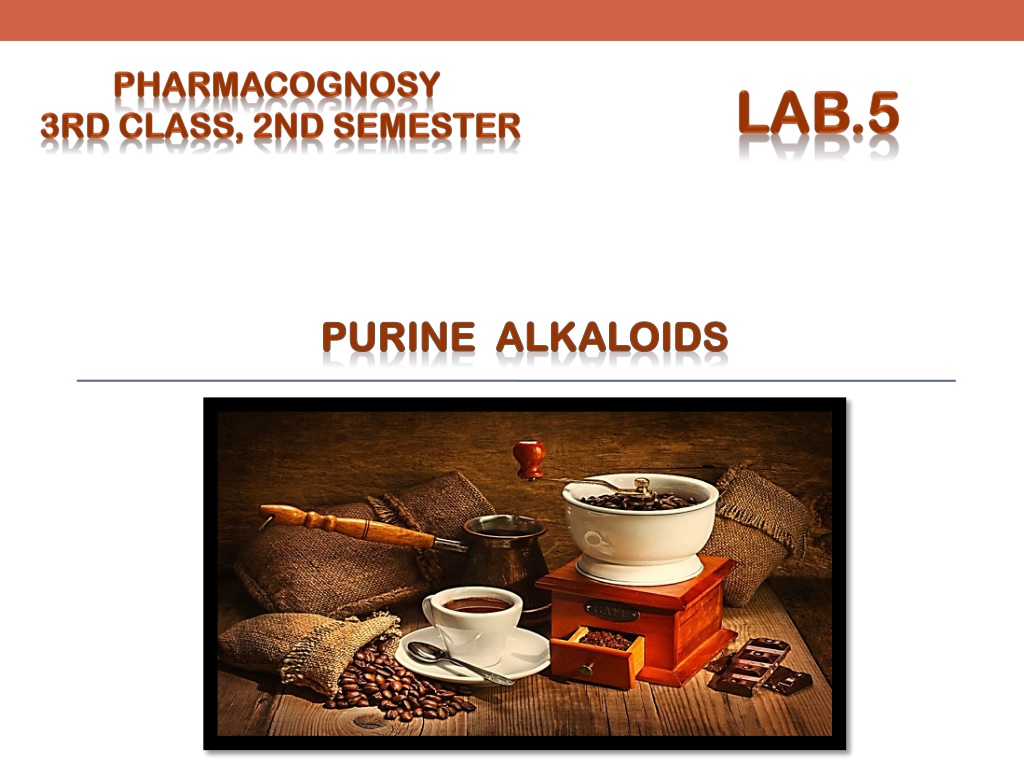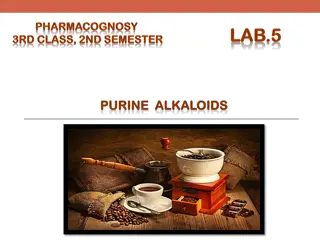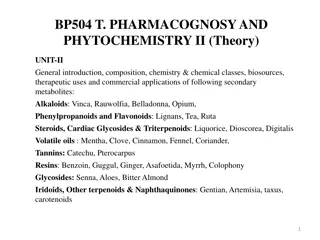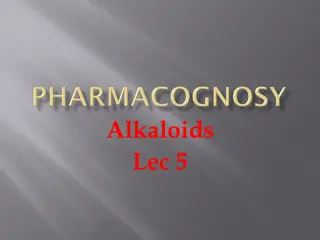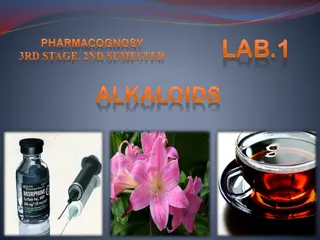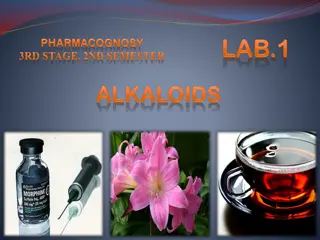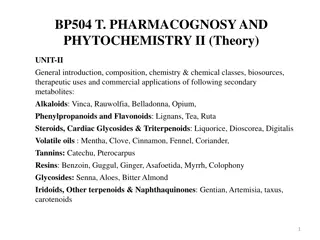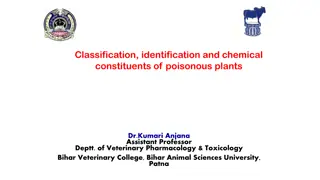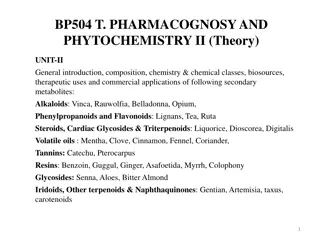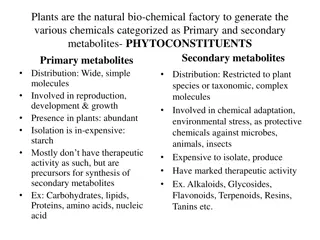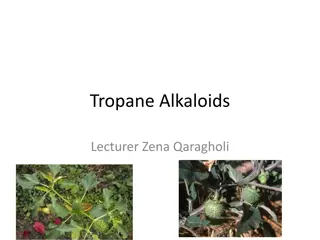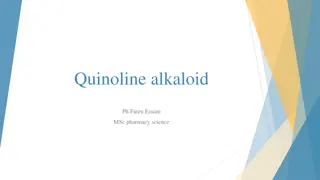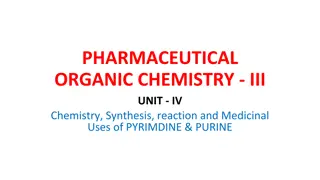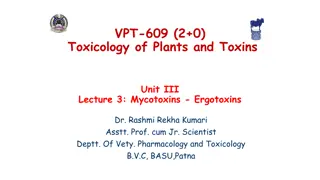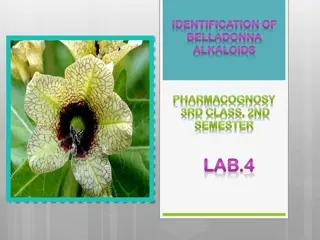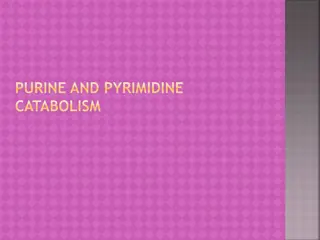Understanding Purine Alkaloids: Properties, Isolation, and Pharmacological Activities
Purine alkaloids are a group of compounds with unique characteristics, such as a heterocyclic nucleus and specific methylated forms like caffeine, theophylline, and theobromine. While they have diverse pharmacological activities like CNS stimulation and diuretic effects, their identification often involves specific tests like the murexide test. Various plants, including coffee, tea, and cola, contain significant amounts of purine alkaloids like caffeine. This article also discusses the isolation of caffeine from tea, outlining the necessary equipment and reagents.
Download Presentation

Please find below an Image/Link to download the presentation.
The content on the website is provided AS IS for your information and personal use only. It may not be sold, licensed, or shared on other websites without obtaining consent from the author. Download presentation by click this link. If you encounter any issues during the download, it is possible that the publisher has removed the file from their server.
E N D
Presentation Transcript
PURINE ALKALOIDS PURINE ALKALOIDS
Introduction Purines nucleus is a heterocyclic nucleus consisting of pyrimidine ring fused to 5-membered imidazole ring known as xanthine.
Cont Amphoteric Character Purines unlike other alkaloids do not give positive results with general tests of alkaloids; instead murexide test (Purple Color) is used in its identification. Purines are present as methylated compound, which are:- 1) Caffeine (1, 3, 7-tri methylxanthine). 2) Theophylline (1, 3,-dimethylxanthine). 3) Theo bromine (3, 7-dimethylxanthine).
Caffeine: stimulates CNS and has a weak diuretic action. Theobromine: it has particularly no stimulant effect on CNS Theophylline: relaxes involuntary muscles more effectively than caffeine or theobromine Caffeine: does not precipitate like most alkaloids.
Generally the pharmacological activities of the Purine Alkaloids 1) Stimulation of the CNS. 2) Diuretic effect. 3) Increase gastric acid secretion. 4) Relaxation of the bronchial smooth muscle (theophylline). 5) Positive inotropic and chronotropic effect on the heart.
The most important plants in this group are:- 1) Coffee (Coffea arabica of the family Rubiaceae) contain about 1-2% of caffeine.
1) Tea (Camellia sinensis of the family Theaceae) contain about 1-4% of caffeine.
Cola (Cola nitida of the family Sterouliaceae) contain about3.5% of caffeine.
Isolation Of Caffeine From Tea AIM: - To isolate the caffeine alkaloid from tea. Equipments and reagent:- Large beaker and small beaker Hot plate Evaporating dish Boiling water Separatory funnel Sodium carbonate (why?) Chloroform(why?)
Take Take 50 50 gm. gm. of coarsely powder tea of coarsely powder tea Add Add 250 250 ml of ml of D. D.w w water and boil gently for water and boil gently for 15 15 min. min. Add 5g of Sodium carbonate and boiled gently Cool, Cool, transfer to a separatory funnel and shake out with three transfer to a separatory funnel and shake out with three successive successive 10 10 ml portion of chloroform ml portion of chloroform
Transfer the combined chloroform extract to a small evaporating dish. Evaporate the chloroform on steam bath in the hood. Scrap out the residue, transfer to a small beaker and dissolve in the smallest quantity of hot 60 c ethanol necessary to affect the solution. Allow the solution to stand overnight.
Results:- Pure crystals with a white color will be obtained. Discussion:- Purines differ from other alkaloids in that they are soluble in hot water, which is used in it is extraction, and this is the cause why all the time you should heat the mixture ( to prevent the precipitation of caffeine in cold water). Addition of sodium carbonate to the water and the tannins will be converted to phenolic anions, which are not soluble in the dichloromethane but are soluble in highly polar water. Addition of charcoal is for the decolorization, so that the crystals will take its normal white color. Use of chloroform is to extract the caffeine from other component of the mixture. Use of hot ethanol is for the recrystallization process.
THANK YOU THANK YOU
